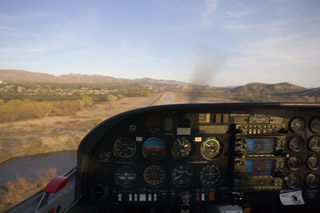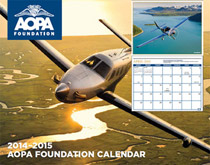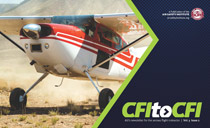 The FAA’s “lack of an executable plan, unresolved technical issues, and ineffective collaboration with industry,” are “programmatic challenges” to moving toward the Next Generation Air Transportation System (NextGen), Department of Transportation Assistant Inspector General for Aviation Audits Matthew Hampton says. Hampton also says that the “FAA continues to face technical, cost, and schedule risks with its efforts to modernize or replace air traffic control automation systems that are fundamental to achieving NextGen benefits.”
The FAA’s “lack of an executable plan, unresolved technical issues, and ineffective collaboration with industry,” are “programmatic challenges” to moving toward the Next Generation Air Transportation System (NextGen), Department of Transportation Assistant Inspector General for Aviation Audits Matthew Hampton says. Hampton also says that the “FAA continues to face technical, cost, and schedule risks with its efforts to modernize or replace air traffic control automation systems that are fundamental to achieving NextGen benefits.”
One technology is Automatic Dependent Surveillance-Broadcast (ADS-B). All users operating in designated airspace must be equipped with ADS-B Out avionics by January 1, 2020.
“There is no incentive for businesses and individual pilots to equip early because the benefits of the NextGen mandate are inadequate and unclear to many general aviation owners and operators,” AOPA Vice President of Government Affairs Melissa Rudinger said. “It is AOPA’s position that the FAA should leverage existing cockpit technologies to move NextGen forward before mandating new equipment.”
The general aviation industry has been reluctant to equip with ADS-B Out avionics because of concerns about installation costs and uncertainty of the benefits the equipment would offer.
ADS-B Out, which broadcasts an aircraft’s ID, current position, altitude, and velocity from on-board equipment, would be required in Class A, B, and C airspace, as well as in Class E airspace above 10,000 feet msl (except airspace below 2,500 feet agl) and within the 30-nautical-mile Mode C veil surrounding Class B airports. ADS-B In (which is not mandated) brings traffic and weather information into the cockpit, letting pilots see what controllers see.
Survey: 81% of AOPA members believe AOPA represents GA in Congress effectively.
Pilot’s Bill of Rights 2
A draft outline for a new Pilot’s Bill of Rights calls for the FAA to act on third class medical reform within 180 days of the General Aviation Pilot Protection Act (GAPPA) becoming law and also would limit Customs and Border Protection’s (CBP) authority to stop and search general aviation aircraft unless there is reasonable suspicion of illegal activity.
U.S. Sen. James Inhofe (R-Okla.), author of the original Pilot’s Bill of Rights, made a draft of the new bill public to solicit feedback before it is formally introduced in the U.S. Senate.
“We can once again thank Senator Inhofe for bringing key general aviation issues before Congress,” said AOPA President Mark Baker. “This new version of the very popular Pilot’s Bill of Rights comes at a time when the GA industry is actively engaged in actions aimed at protecting pilots’ civil liberties and the freedom to fly.”
In addition to language around third class medical reform and placing limits on CBP stops and searches, the draft also includes provisions to expedite updates to the Notice to Airmen (NOTAM) program; limit the liability of aviation medical examiners, designated pilot examiners, and designated airworthiness representatives; make local airport authorities “the sole authority” on the use of privately built and owned hangars at airports that received federal funds; and a placeholder has been left in the draft regarding how best to add safety-enhancing equipment to the existing fleet of GA airplanes. It further defines the applicability of Freedom of Information Act requests to contract towers and other FAA contractors, and includes several updates to expand the original Pilot’s Bill of Rights.
“The Pilot’s Bill of Rights 2 will continue and expand on the improvements that were accomplished just two years ago with the original Pilot’s Bill of Rights,” Inhofe said. “Input from the aviation community is essential to addressing the needs of aviators and industry alike. I look forward to working closely with stakeholders to develop a final product and ensure this vital piece of legislation makes necessary reforms, cuts red tape, and is signed into law.”
President Obama signed the first Pilot’s Bill of Rights in August 2012. That bill guarantees pilots under investigation by the FAA expanded protection against enforcement actions via access to investigative reports, and air traffic control and flight service recordings. It also requires the FAA to provide the evidence being used as the basis of enforcement at least 30 days in advance of action.
Web: www.inhofe.senate.gov/feedback/pbor2
Pilot Protection
When it comes to family, safer is better
AOPA is pleased to announce an expansion of the AOPA AD&D Protection Plan. To help you provide a safety net for your family, coverage is now available for spouses and children. As an AOPA member, you can elect to cover a spouse and children as an extension of your AD&D policy.
No matter how safe you are when you fly, how courteous a driver you are on the road, or how careful you are at home, there are many things beyond your control. While you can’t control when and if an accident occurs, you can help manage the impact it has on you and your family with the AOPA AD&D Protection Plan. If a covered accident takes your life or leaves you seriously injured, you can make sure your family will have help paying the bills and continuing their lifestyle.
With the AOPA AD&D Protection Plan, you’re protected anywhere, 24/7, which means any family members covered by your insurance are also protected anywhere, 24/7. You pay the same rate no matter your age or level of flying experience, and this new enhanced program also covers all common accidents in addition to flying-related activities for the same affordable low rate. For more information or to enroll in this plan, go online (www.aopainsurance.org) or call us at 877-432-2672.
 2015 calendar available now
2015 calendar available now
Reserve your copy of our 2015 AOPA Foundation calendar by making a donation to support the future of GA. This 14-month calendar is filled from front to back with spectacular aviation images to remind you of the fun you’ve had, the places you’ve been, and the friends you’ve made along the way—and of the personal impact you’re having on general aviation’s future through your generous AOPA Foundation support.
Web: 2015 Calendar
Airport Support Network
ASN volunteer organizes airport takeover
A group of airport supporters officially took over leadership and day-to-day operations of the Sutter County Airport from Sutter County, California.
Sutter Buttes Regional Aviation Association (SBRAA), a local nonprofit comprising pilots, aviation advocates, business supporters, friends, and families, “committed to fully assuming the ongoing operation, maintenance, improvement, and growth” of the airport.
AOPA Airport Support Network volunteer and Sutter Buttes Regional Aviation Association President Joe Borzelleri organized airport tenants, pilots, and aircraft owners to run the airport, located on approximately 170 acres of land just east of Garden Highway. AOPA provided advice and counsel on forming the local pilot association and resources for becoming a nonprofit pilot group.
The idea of an independent board running the airport came from Jack Kemmerly, who has worked for AOPA and the Caltrans Department of Aviation. Borzelleri ran with it, with support from several others. AOPA and the California Pilots Association helped the group, which was founded in March 2012, incorporate as a nonprofit in California.
Are you someone who is taking the lead to preserve your airport? Maybe you should be AOPA’s ASN volunteer.
Learn more online.
AOPA Foundation
Together we can make a difference. Join the AOPA member philanthropists who have funded AOPA Foundation initiatives this year
(www.aopafoundation.org/donate).
air safety institute
Learn from each other
Check out ASI’s ‘CFIto CFI’ newsletter
 The Air Safety Institute publishes and distributes CFI to CFI, its free and award-winning digital newsletter, to certificated flight instructors in the United States. Whether you’re an active flight instructor or getting back into the cockpit, you can access this quarterly publication anywhere, anytime.
The Air Safety Institute publishes and distributes CFI to CFI, its free and award-winning digital newsletter, to certificated flight instructors in the United States. Whether you’re an active flight instructor or getting back into the cockpit, you can access this quarterly publication anywhere, anytime.
The newsletter is a forum for CFIs to learn from each other and it includes information on—and links to—a wealth of aviation safety education programs. CFI to CFI embeds safety videos for seamless viewing on a tablet or PC, while providing thought-provoking flight-instruction-related articles and videos, flight instruction and aviation education tips from flight instructors, and ASI’s well-known safety quizzes and courses to share with student pilots and others.
In this issue (www.nxtbook.com/nxtbooks/aopa/cfi_vol5issue2/), watch the video of a CFI’s “Real Pilot Story: Fire in the Cockpit,” explore ways to improve your radio communication with ATC, and come along with Rod Machado on an experiment of flying under the influence of density altitude. Not a CFI? No problem: Subscribe online.
Use ASI’s ‘Safety To Go’ portal to share free safety education content
 Take the opportunity to share general aviation safety information at a local community event and download ASI’s top-notch accident case studies, real pilot stories, and safety videos. ASI recently added its popular “Chart Challenge—Live” seminar presentation—a great refresher clinic to put your audience’s knowledge to the test. New products are added quarterly, so please check back frequently to find more of your favorite products (www. airsafetyinstitute.org/product-download).
Take the opportunity to share general aviation safety information at a local community event and download ASI’s top-notch accident case studies, real pilot stories, and safety videos. ASI recently added its popular “Chart Challenge—Live” seminar presentation—a great refresher clinic to put your audience’s knowledge to the test. New products are added quarterly, so please check back frequently to find more of your favorite products (www. airsafetyinstitute.org/product-download).
Visit ASI for dates and locations.
Do you like to live on the edge?
Living on the edge is not without its perils. Some are minor, but some can be downright dangerous. Take thunderstorms, for instance. Venturing too close to the turbulence associated with these weather hazards can ruin your day pretty quickly.
In the Air Safety Institute’s Living on the Edge Pilot Safety Announcement video (www.airsafetyinstitute.org/PSAturbulence), ASI reminds pilots of the discomfort (at best) and disaster (at worst) these storms can bring. Living on the edge might be exciting, but don’t get too close to the edge lest convective turbulence brings you down.
Pilot Protection Services
Medications and side effects
Drugs can affect performance as altitude increases
The FAA is continually concerned about the use of medications and the potential adverse side effects. Sedating medications are found as a possible contributing factor in a significant number of fatal aviation accidents. Certain drugs, even over-the-counter drugs (OTCs), may produce adverse side effects that can affect cognitive function, including reaction time, judgment, and decision making skills—all of which are needed while flying.
AOPA is nearing completion of an online educational course that will help pilots better understand some of the basic physiology of the body in the aviation environment. A section of that course deals with the interactions of medications and how those drugs can affect performance as altitude increases. Certain medications, including antihistamines and OTC cold remedies, contain ingredients that are sedating and that have long half-lives—the period of time required after taking a drug for its effectiveness to be reduced by 50 percent. The effects of a medication while you’re on the ground may be negligible; but at even relatively low altitudes, the effects of those medications may cause potentially incapacitating side effects.
This brings me to a question we receive a few questions on—medical marijuana. Twenty-one states allow the use of medical marijuana, and at least two states have now decriminalized/legalized the possession of small quantities for recreational use. Federal law still preempts state laws, and marijuana is still—and most probably will continue to be—an illegal substance under existing federal statutes. The use of cannabis, whether legal or not, is an unsafe practice in the aviation environment. It is one of the five tested drugs under the federal drug abatement guidelines, and is often detected in preemployment and random drug testing in the aviation industry.
Marijuana can affect your cognition (attention, memory, and learning) and its effects can linger for up to 24 hours after use. It can impair your memory of recent events. It causes difficulty concentrating, a dreamlike state, impaired motor coordination, impaired driving skills, slowed reaction time, and may alter your peripheral vision.
Education about all medications is important, so if you have questions about a drug you are prescribed or currently are taking, please contact AOPA’s medical staff.
Dr. Warren Silberman is the former manager of FAA Aerospace Medical Certification and a doctor of osteopathic medicine. A pilot since 1986, he is recognized nationally as an expert in aerospace/preventive medicine, and is a regular writer for AOPA’s Pilot Protection Services.
Answers for Pilots: Airman medical certification
A lot has changed over the years
Perhaps you’ve held an airman medical certificate for a couple of decades, but you haven’t been flying much lately and your medical certificate has lapsed. However, your daughter has caught the flying bug and her excitement is contagious. As you talk with her about getting her medical certificate, and describe the form, she tells you she knows about that. She pulls out her iPad and shows you the MedXpress website, catching you by surprise. The paper form is no longer used; you must apply online. If you wonder what else has changed in regard to medical certification over the past few years, read September’s Answers for Pilots (online). And look for additional information on the topic in an upcoming webinar, a short video, and a podcast—all brought to you by AOPA Pilot Protection Services.
MedXpress
Successfully completing your next medical online
Find out what it takes to complete the FAA’s online medical application in this AOPA Live This Week video featuring Dr. Warren Silberman.
Learn more about (AOPA Pilot Protection Services).
Insurance Services
Testimonial: Fear of flying led this AOPA member to flight lessons
Professional comedian counts on AOPA for renter’s insurance
Kevin Hughes learned to fly because of a scary moment on an airliner in turbulence. He says, “When we landed, after being diverted to another airport for an emergency landing, I called my wife and told her to find me a flight school.” His reasoning? “If I am ever that scared again, I at least want to know what’s going on,” he says.
Now, with approximately 500 hours, Hughes belongs to a flying club and also to OpenAirplane, where you rent airplanes the same way you’d rent a car. “As long as you are checked out in the airplane you usually fly, then anyone who has that type airplane can rent it to you. I am getting checked out in the three airplanes I fly most: Cessna, Piper, and the [Diamond] DA40,” he says.
Hughes is a retired professional comedian who worked for the past 13 years for Princess Cruise Lines. Working on a cruise ship wasn’t conducive to flying, but when he retired in 2013, he decided to get back in the cockpit. He has been an AOPA member since 1991 and says he has always had a good experience with AOPA products and services. After being away from flying for almost a decade, he called AOPA and asked for advice. Then he called AOPA again about insurance. He was told flat out: “Buy renter’s insurance.”
“I can use AOPA renter’s insurance both for my flying club and my OpenAirplane account. I can rent anywhere I am checked out, and the insurance covers me,” he says. He was impressed with the customer service he received from AOPA insurance, which took an hour to explain the options and what is and isn’t covered.
With the flexibility renter’s insurance from AOPA provides, Hughes says, “The sky is the limit—except on price. I don’t pay a whole lot. In fact, I paid the entire year with one check. I am retired and on a fixed income, so every penny counts. The money I saved on insurance paid for two more hours in the air.”
When you rent aircraft, give yourself the peace of mind that AOPA Renter’s Insurance provides. For more information or a quick quote on aircraft insurance, talk to AOPA Insurance. Don’t forget: You may earn a 5-percent discount just for being an AOPA member.
AOPA Insurance Services is celebrating 20 years of serving the aviation insurance needs of our customers. Visit us online or call 877-622-2672 for information on how AOPA can get you the best deal on aviation and life insurance.


